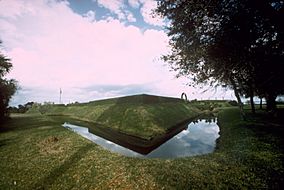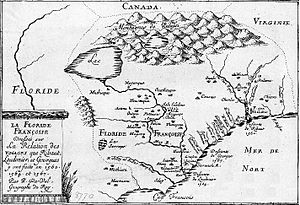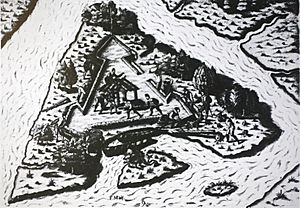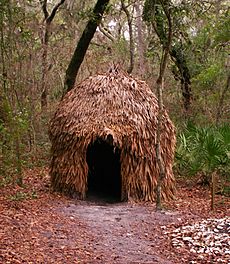Fort Caroline facts for kids
Quick facts for kids Fort Caroline National Memorial |
|
|---|---|
 |
|
| Location | Arlington, Jacksonville, Florida, United States |
| Area | 138.39 acres (56.00 ha) |
| Established | 16 January 1953 |
| Visitors | 145,736 (in 2005) |
| Governing body | National Park Service |
| Website | Fort Caroline National Memorial |
|
Fort Caroline National Memorial
|
|
| Lua error in Module:Location_map at line 420: attempt to index field 'wikibase' (a nil value). | |
| Nearest city | Jacksonville, Florida |
| Area | 128 acres (51.8 ha) |
| Built | 1564 |
| NRHP reference No. | 66000061 |
| Added to NRHP | 15 October 1966 |
Fort Caroline was an early French settlement in what is now Florida. It was built by French colonists on the banks of the St. Johns River in 1564. The French wanted to claim this land before Spain did.
The settlement was led by René Goulaine de Laudonnière and included Huguenot settlers. Huguenots were French Protestants who faced challenges in their home country. The fort was named after King Charles IX.
Fort Caroline didn't last long. It soon faced conflict with the Spanish, who built their own settlement, St. Augustine, nearby in 1565. Spanish troops attacked and took over Fort Caroline in September 1565. The Spanish then occupied the site for a few years.
Today, the exact spot of the original fort is unknown. However, the National Park Service created the Fort Caroline National Memorial in 1953. It's located near where the original fort is believed to have stood. This memorial is now part of the Timucuan Ecological and Historic Preserve.
Contents
History of French Florida
Charlesfort: An Earlier Attempt (1562–1563)
Before Fort Caroline, another French group tried to settle in Florida. In May 1562, an expedition led by French explorer Jean Ribault landed near the St. Johns River. They met the Timucua people, led by Chief Saturiwa.
Ribault left some of his troops further north in present-day South Carolina. There, they built a small settlement called Charlesfort. Ribault then sailed back to Europe to get more supplies. However, he was captured in England and couldn't return.
Without supplies or a leader, the Charlesfort colonists struggled. They faced problems with local native groups. After a year, most of them decided to sail back to Europe. Their journey was very difficult, and some even resorted to cannibalism to survive. The remaining survivors were eventually rescued. Another French group briefly rebuilt a fort there in 1577–1578.
Fort Caroline: A New Start (1564–1565)
In June 1564, René Goulaine de Laudonnière led about 200 new French settlers to Florida. Laudonnière had been Ribault's second-in-command on the earlier trip. They built Fort Caroline on a high bank near the St. Johns River.
Life at Fort Caroline was hard. The settlers faced hunger and many left the fort. The Spanish government also noticed the French presence. They saw it as a challenge to their claims in the area.
The French settlers relied a lot on the local Timucua people for food and trade. The Timucua initially welcomed them. French soldiers explored Timucuan lands, looking for gold and silver, but didn't find any.
Sometimes, the French got involved in conflicts between different Timucuan groups. For example, Chief Outina asked the French to help him attack his rivals, the Potano, to get corn. However, some French soldiers who left the fort caused trouble with the Timucua. This made relations difficult. In 1565, the French even took Chief Outina hostage, leading to fights. They eventually released him.
In July 1565, an English adventurer named John Hawkins visited Fort Caroline. He traded one of his ships for cannons and supplies. This help allowed the French to survive and plan to return to France. Laudonnière wrote that Hawkins was a "good and charitable man." The French also introduced tobacco to Hawkins, who then took it back to England.
In late August, Jean Ribault returned to Fort Caroline with many more soldiers and settlers. He took command of the colony. However, the Spanish Governor of Florida, Pedro Menéndez de Avilés, also arrived at the same time. His mission was to remove the French.
After a small fight at sea, Menéndez's ships sailed south and established St. Augustine. Ribault followed the Spanish with most of his ships and troops. But a huge storm hit, scattering Ribault's fleet.
Meanwhile, Menéndez marched his forces overland during the storm. He launched a surprise attack on Fort Caroline at dawn on September 20. The fort had about 200 to 250 people. Only about 50 women and children were taken prisoner. A few defenders, including Laudonnière, managed to escape. Most of the others were killed.
Ribault's ships were wrecked south of St. Augustine by the storm. Many Frenchmen were lost at sea. Ribault and his surviving sailors marched north. Menéndez found them and demanded their surrender. Ribault surrendered, believing his men would be treated well. However, Menéndez then executed Ribault and hundreds of other French Protestants. This happened at a place now called Matanzas Inlet, which means "slaughters" in Spanish. This terrible event shocked people across Europe. A fort called Fort Matanzas was later built near this site. This massacre ended France's attempts to settle this part of North America for a while.
The Spanish destroyed Fort Caroline and built their own fort there. But in April 1568, a French force led by Dominique de Gourgues attacked and burned the fort. He killed the Spanish prisoners to get revenge for the 1565 massacre. The Spanish rebuilt the fort, but they left it for good the next year. The exact spot of the fort is still unknown.
Free Black Population at Fort Caroline
When the Spanish leader Pedro Menéndez founded St. Augustine in 1565, he noted that free Africans were already living in the French settlement at Fort Caroline. The fort also used Black enslaved labor. This means that Fort Caroline and the St. Augustine area are important places in the early history of the Black community in what would become the United States.
Fort Caroline Today: Reproductions and Ideas
The original location of Fort Caroline has never been found. However, it's thought to be near the current Fort Caroline National Memorial. In 1964, the National Park Service built an outdoor display of the fort, but it was destroyed by Hurricane Dora that same year.
Today, there is a second replica at the memorial. It's a nearly full-size model of the original Fort Caroline. This model helps visitors understand the simple defenses the French colonists used in the 1500s.
Where Was the Real Fort Caroline?
Some researchers have suggested that Fort Caroline was not on the St. Johns River in Florida. In 2014, Fletcher Crowe and Anita Spring claimed it was on the Altamaha River in southeast Georgia. They pointed to old French maps that might support this idea. They also said that the Native Americans near the fort spoke Guale, a language from coastal Georgia, not Timucua, which was spoken in northeast Florida.
However, other experts are doubtful. They say the old maps are not strong proof. They also think the Georgia location is too far from St. Augustine for the Spanish to have marched there in just two days during a hurricane.
Gallery
See also
 In Spanish: Fuerte Caroline para niños
In Spanish: Fuerte Caroline para niños








